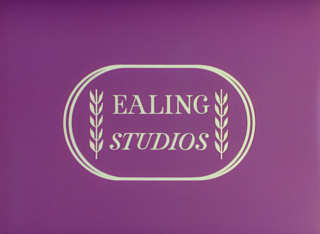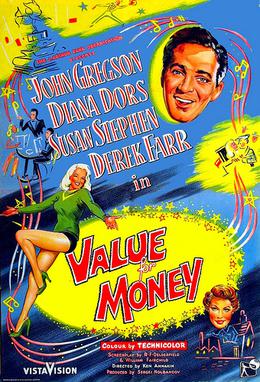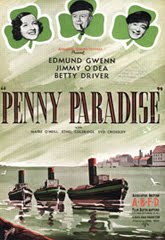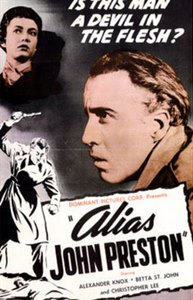
The Ealing comedies is an informal name for a series of comedy films produced by the London-based Ealing Studios during a ten-year period from 1947 to 1957. Often considered to reflect Britain's post-war spirit, the most celebrated films in the sequence include Kind Hearts and Coronets (1949), Whisky Galore! (1949), The Lavender Hill Mob (1951), The Man in the White Suit (1951) and The Ladykillers (1955). Hue and Cry (1947) is generally considered to be the earliest of the cycle, and Barnacle Bill (1957) the last, although some sources list Davy (1958) as the final Ealing comedy. Many of the Ealing comedies are ranked among the greatest British films, and they also received international acclaim.

Sir Michael Elias Balcon was an English film producer known for his leadership of Ealing Studios in West London from 1938 to 1955. Under his direction, the studio became one of the most important British film studios of the day. In an industry short of Hollywood-style moguls, Balcon emerged as a key figure, and an obdurately British one too, in his benevolent, somewhat headmasterly approach to the running of a creative organization. He is known for his leadership, and his guidance of young Alfred Hitchcock.

Belinda Lee was an English actress.

Mae Clarke was an American actress. She is widely remembered for playing Henry Frankenstein's bride Elizabeth, who is chased by Boris Karloff in Frankenstein, and for being on the receiving end of James Cagney's halved grapefruit in The Public Enemy. Both films were released in 1931.
MGM-British was a subsidiary of Metro-Goldwyn-Mayer initially established at Denham Film Studios in 1936. It was in limbo during the Second World War; however, following the end of hostilities, a facility was acquired in Borehamwood, which remained in use until it was closed in 1970.

Matron is the job title of a very senior or the chief nurse in several countries, including the United Kingdom, and other Commonwealth countries and former colonies.

The Ship That Died of Shame, released in the United States as PT Raiders, is a black-and-white 1955 Ealing Studios crime film directed by Basil Dearden and starring Richard Attenborough, George Baker, Bill Owen and Virginia McKenna.

The Night My Number Came Up is a 1955 British supernatural drama film directed by Leslie Norman with screenplay by R. C. Sherriff. The film stars Michael Redgrave, Sheila Sim and Alexander Knox.

Who Done It? is a 1956 British slapstick black and white comedy crime film directed by Basil Dearden and starring Benny Hill, Belinda Lee, David Kossoff, Garry Marsh, and George Margo. One of the last Ealing comedies, it was Hill's film debut.

Value for Money is a 1955 British comedy film directed by Ken Annakin and starring John Gregson, Diana Dors, Susan Stephen and Derek Farr. It is based on the 1953 novel of the same name by Derrick Boothroyd.

The Man in the Sky is a 1957 British thriller drama film directed by Charles Chrichton and starring Jack Hawkins and Elizabeth Sellars. A test pilot strives to land a stricken prototype plane.

Eyewitness is a 1956 British thriller film directed by Muriel Box and starring Donald Sinden, Muriel Pavlow, Belinda Lee, Michael Craig, Nigel Stock and Richard Wattis. It was Produced by Sydney Box for the Rank Organisation.

As Long as They're Happy is a 1955 British musical comedy film directed by J. Lee Thompson and starring Jack Buchanan, Susan Stephen and Diana Dors. It is based on the 1953 play of the same name by Vernon Sylvaine. It was shot in Eastmancolor at Pinewood Studios near London with sets designed by the art director Michael Stringer.

Lease of Life is a 1954 British drama film made by Ealing Studios and directed by Charles Frend. The film was designed as a star vehicle for Robert Donat in his return to the screen after a three-year absence.

Penny Paradise is a 1938 British comedy film directed by Carol Reed and starring Edmund Gwenn, Betty Driver and Jimmy O'Dea.

The National Health is a 1973 British black comedy film directed by Jack Gold and starring Lynn Redgrave, Colin Blakely and Eleanor Bron. It is based on the 1969 play The National Health by Peter Nichols, in which the staff struggle to cope in a NHS hospital.

No Time for Tears is a 1957 British drama film directed by Cyril Frankel in CinemaScope and Eastman Color and starring Anna Neagle, George Baker, Sylvia Syms and Anthony Quayle. The staff at a children's hospital struggle with their workload.

Alias John Preston is a 1955 British 'B' thriller film directed by David MacDonald and starring Christopher Lee, Betta St. John and Alexander Knox. A mysterious and wealthy man moves to a small village where he outwardly appears to be a friendly figure but nurses a dangerous secret.

Passport to Treason is a 1956 British second feature mystery thriller directed by Robert S. Baker and starring Rod Cameron, Lois Maxwell, and Clifford Evans. It was written by Kenneth R. Hayles and Norman Hudis, based on the Manning O'Brine novel of the same name.
Henryetta Edwards was a British actress on the London stage, and in films and television, mostly in the 1940s and 1950s.



















